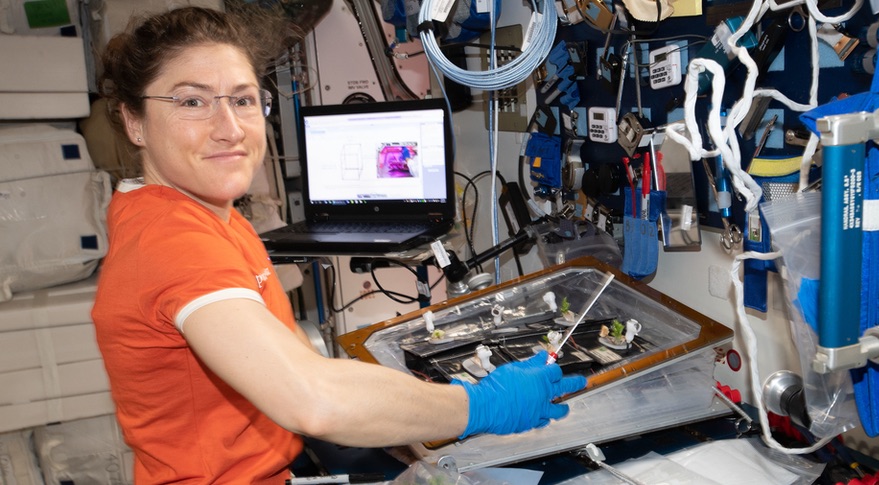
WASHINGTON — Two NASA astronauts will get extended stays on the International Space Station, NASA announced April 17, a move intended to support research on long-duration spaceflight and address uncertainties in the availability of commercial crew vehicles.
NASA said that Christina Koch, an astronaut who launched to the station March 14, will remain on the station until February 2020. Koch will spend an estimated 328 days on the station, breaking the record for the longest single spaceflight by a woman held by Peggy Whitson at 288 days in 2016 and 2017, and coming close to the record for the longest American spaceflight, the 340-day flight of Scott Kelly in 2015 and 2016.
Andrew Morgan, set to launch on a Soyuz mission July 20, will remain on the station until the spring of 2020, for an estimated 255 days in space. Morgan will launch with European astronaut Luca Parmitano and Russian cosmonaut Alexander Skvortsov, but return with NASA’s Jessica Meir and Russia’s Oleg Skripochka, launching in September.
There had been rumors for weeks that Koch and/or Morgan would get extended stays on the station. On April 16, the Russian news agency Sputnik, citing Russian space industry sources, said that Koch would spend 11 months on the station. The topic was also likely to come up at an April 19 press conference NASA previously scheduled with Morgan, Parmitano and Skvortsov.
In a video interview released by NASA, Koch said she was excited about the prospect of an extended stay on the station. “It feels awesome,” she said. “I have known that this was a possibility for a long time, and it’s truly a dream come true to know that I can continue to work on the program that I have valued so highly my whole life.”
She said that both she and Morgan had talked with Kelly and Whitson to get advice from them about what to expect for a long stay on the station when they found out their missions could be extended. That advice, she said, included “find what you love and make sure you have it up there” and to pace out their work on the station.
In a statement, NASA said the extended durations will add to the limited knowledge base about the effects of long-duration spaceflight on the human body. “NASA is looking to build on what we have learned with additional astronauts in space for more than 250 days,” said Jennifer Fogarty, chief scientist of the Human Research Program at NASA’s Johnson Space Center. “Christina’s extended mission will provide additional data for NASA’s Human Research Program and continue to support future missions to the moon and Mars.”
NASA also acknowledged in that statement that the revised schedule “also allows NASA to get the most time dedicated to other research aboard the station, as U.S. commercial crew launch providers prepare for operations to and from U.S. soil and the space station.”
With questions about whether either Boeing or SpaceX would be certified for regular crew rotation missions by the end of this year, NASA had been looking for ways to extend its presence on the station. In February, the agency revealed in a procurement filing that it was in discussions with Roscosmos to purchase two Soyuz seats that the Russians were not planning to use for flights to the station in the fall of 2019 and spring of 2020.
NASA announced April 3 that it had approved a proposal previously under study to use the crewed test flight of Boeing’s CST-100 Starliner as a long-duration mission to the station. NASA astronauts Nicole Mann and Mike Fincke, along with Boeing commercial astronaut and former NASA astronaut Chris Ferguson, will spend up to several months at the station, although the exact duration has yet to be determined. That launch is not expected before late this year, after an uncrewed test flight currently slated for August.
SpaceX carried out an uncrewed test flight of its Crew Dragon vehicle in March that both NASA and the company considered to be a success. The agency hasn’t set a date for a crewed test flight with NASA astronauts Bob Behnken and Doug Hurley, who will spend only a short time on the station, but it will take place no sooner than July.
The reshuffled schedule also gives Roscosmos an opportunity to fly an astronaut from the United Arab Emirates, Hazza Al Mansouri, on a short-duration mission to the station. Al Mansouri was originally scheduled to fly to the ISS in March with Koch and Skripochka, and then return with Nick Hague and Alexey Ovchinin. However, the aborted October 2018 launch of the Soyuz MS-10 spacecraft carrying Hague and Ovchinin disrupted those plans.
In December, Hague and Ovchinin were assigned to the Soyuz MS-12 spacecraft that launched in March with Koch, replacing Skripochka and Al Mansouri. Under the new plan, Al Mansouri will fly to the station in September with Meir and Skripochka, and return in early October with Hague and Ovchinin.
Bagikan Berita Ini














0 Response to "Two NASA astronauts to get extended ISS stays - SpaceNews"
Post a Comment